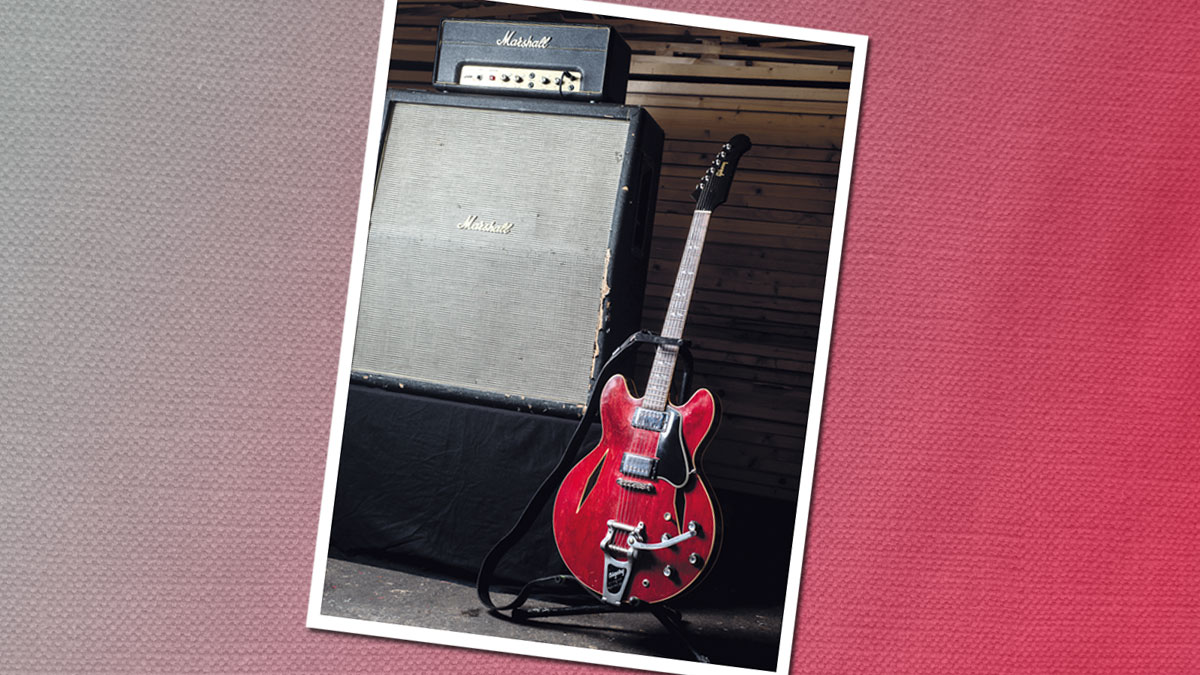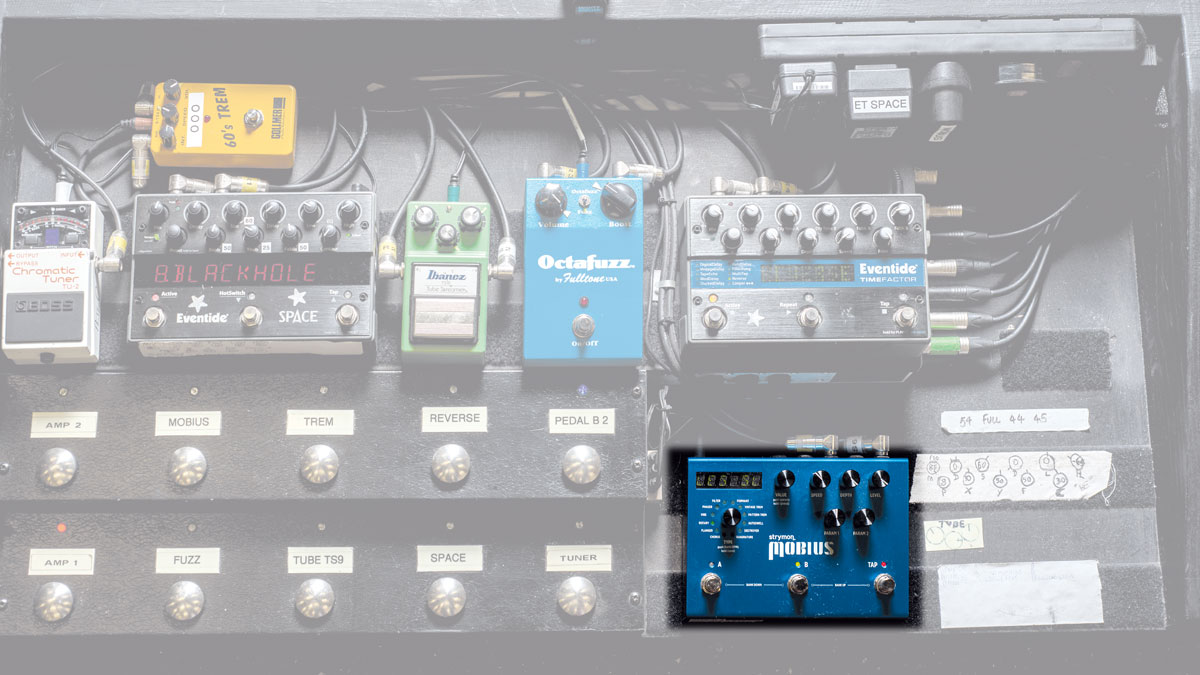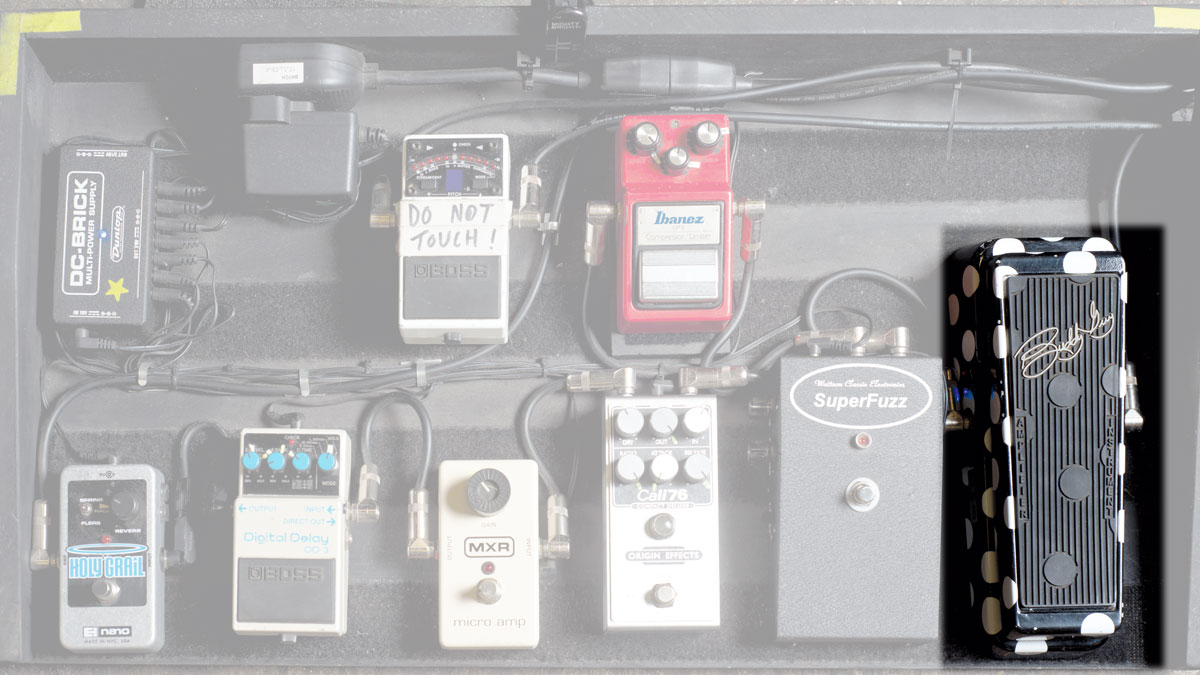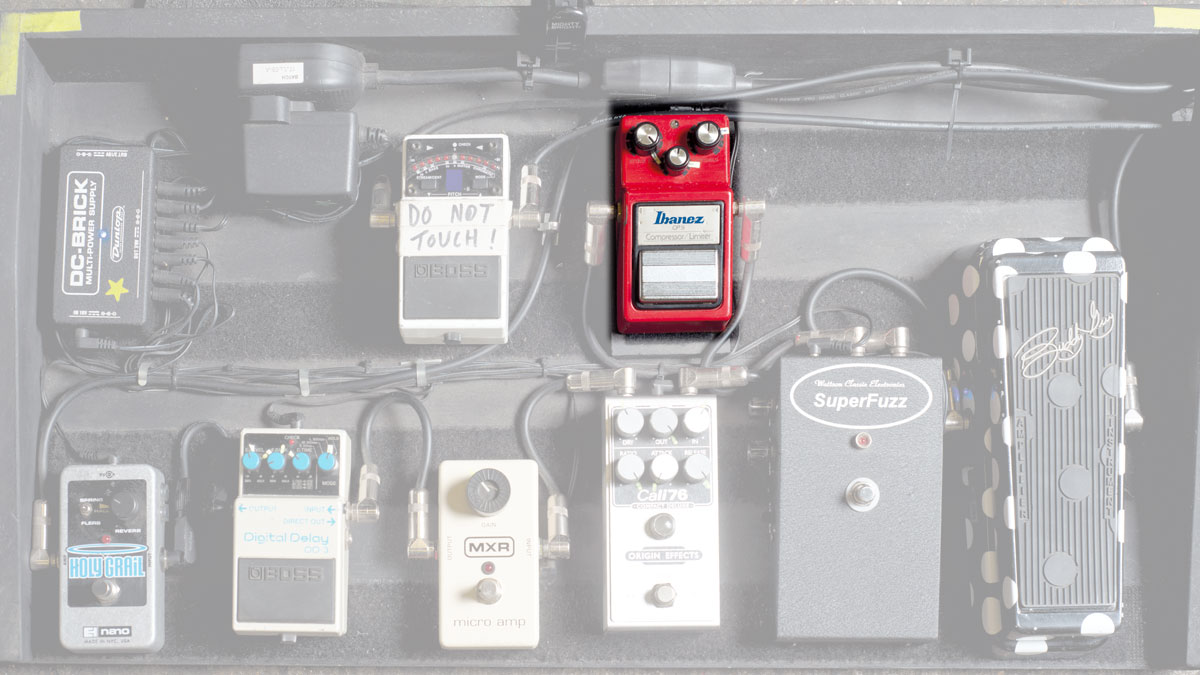Andy Bell talks returning to Ride and his Rickenbacker'd rig
The story behind the innovative rock band's reformation

Introduction
Andy Bell tells us about returning to his guitar roots after Beady Eye and Oasis with Ride’s 2015 reunion...
Back in the early 90s, it seemed that youthful Oxford four-piece Ride had a huge future ahead of them and were on course to become one of indie’s big hopes for the new decade.
The group’s early sound was dominated by the oft-ethereal effects-heavy attack of Andy Bell and Mark Gardener’s guitars, ingeniously fused with their hook-laden 60s vocal melodies and the solid grooves of drummer Loz Colbert and bassist Steve Queralt.
Rides’s early sound was dominated by the oft-ethereal effects-heavy attack of Andy Bell and Mark Gardener’s guitars
Along with the likes of Slowdive, Chapterhouse, Moose and Lush, Ride were lumped into the ‘shoegazing’ scene by the British music press, who invented the term for non-confrontational bands that spent a fair amount of time staring at the floor and/or their pedalboards during gigs.
In recent years, shoegaze has of course once again come into common (although decidedly more positive!) parlance, with contemporary acts citing Ride and others of that era as an important influence.
Ride’s first two classic albums, Nowhere (1990) and Going Blank Again (1992) on Creation Records, peaked at number 11 and five respectively in the UK charts. But, after two more conventionally rock records, the guys sadly parted ways in 1995, with Andy going on to form Hurricane #1, before joining Oasis on bass and then moving back to guitar in Beady Eye with Gem Archer and Liam Gallagher in 2009.
However, in November 2014 it was announced that Ride were to reform after 20 years apart. The first tour, in April and May of this year, met with rapturous receptions and critical acclaim. Now their next batch of dates are eagerly anticipated by fans both old and new alike.
We catch up with Bell to find out all about the reunion and the Ride tones of the past and present…
Don't Miss

Coming home
Back in April, Ride played their first gigs for 20 years. Did it feel like ‘coming home’?
“Yeah, it did, and the first gig was in our hometown, Oxford, at a venue [O2 Academy Oxford, formerly The Zodiac] that we played many times and where we used to rehearse so that really did feel like coming home!
I’ve realised everything I have done since Ride is because of Ride and my roots as a player always go back to Ride
“With Dreams Burn Down, I’d made a four-track demo tape in my bedroom and the first time we played it as a band was in that room during a rehearsal. I remember Loz figuring out what beat to play on that song while we were there and it suddenly sounded huge so, yeah, that’s a room that means a lot to us.
“As a musician though, I’ve realised everything I have done since Ride is because of Ride and my roots as a player always go back to Ride.”
Why did you decide to reform this year?
“Well, I guess it’s been something that’s been on our minds for a few years because there’s been quite a bit of interest in that kind of music, especially from America. It seems like it’s in vogue again, more than it was at the time.
“Every year or two, we’d get asked to do gigs and it would be of laughed off. I wasn’t really into the reunion thing until recently… that changed when I saw The Stone Roses and the Valentines [My Bloody Valentine] reunions. The Roses were my favourite band… and to see them pull it off with such panache did change something for me.”
How did it feel when the music press started categorising Ride as a ‘shoegazing band’?
“Slightly annoyed but kind of proud in a weird way because we were being noticed… but to be noticed with a word that they were probably using as an insult is a bit weird! It didn’t happen that much while we were together but I saw it a couple of times in print. Then, after we’d split up, ‘shoegazing’ got shortened to ‘shoegaze’ by Americans and started getting used as a compliment.
“When I started touring the US with Oasis, I’d get people coming up and saying, ‘I love shoegaze! I love Ride!’ Now, I’m totally cool with the term. I’m not saying we started it but we were one of the first bands in that style. It’s probably most encapsulated by the Valentines or Slowdive with the washy, dreamy thing. We had a lot of that going on but we were quite a muscular live band. I saw us as being like The Who or something…”

Ride that train
Can you hear Ride’s influence on many contemporary shoegaze bands?
“Maybe… but I don’t know whether they are influenced or not. I don’t know whether they just listen to the same stuff we listened to. We were basically translating our version of a certain crop of 60s bands - The Beatles, The Byrds, The Velvets [The Velvet Underground] and The Stooges - and putting that through a filter of what was going on right then. The [Jesus And] Mary Chain, the Valentines, the House Of Love and Spacemen 3.”
What guitars and amps were you playing across Ride’s early EPs and the debut Nowhere album?
As soon as we got our advance, I bought a Gretsch Tennessean, two Rickenbacker 12-strings, a Hiwatt head and a Marshall cab
“When we started, I had a semi-acoustic 335 copy called a Satellite, which was probably about 80 quid and which I actually played on Top Of The Pops with Ride. Mark’s uncle had this red semi-acoustic that was really nice and I played that in the Chelsea Girl video. That was Mark’s main guitar at the beginning and he had another shit solidbody thing that he’d got from somewhere.
“I also had a Vox amp but it was a transistor one, which sounded horrible. All the first records had that on. I didn’t get any decent gear until we got signed but, then again, we got signed after six gigs so it didn’t take long.
“As soon as we got our advance through, I went and bought a Gretsch Tennessean, two Rickenbacker 12-strings, a Hiwatt head and a Marshall cab. Mark had the full Marshall stack but I found it a bit too rock because I was going for a cleaner sound.”
What were your key effects back then?
“We both bought these GP-16s, which were the Roland rack effect units that we used to get all of the early Ride sounds. It was a rack and it was programmable and you had a foot controller with eight switches and different banks.
“It felt like you had an infinite number of sounds. You’d just go through and laboriously turn this little wheel to set the levels of everything that you wanted. You’d choose compressor - on or off? Always on! Then you’d choose the amount of delay you wanted and the phaser and this and that. I think [the GP-16] is the Ride sound, really.
“For the first album Nowhere, it was the Rickenbacker 12-string going into the GP-16 coming out into the Vox 100-watt transistor amp and the Marshall going through the Hiwatt.
“It was stereo sound, too, because only one of the amps had the [Jim Dunlop Jimi Hendrix Cry Baby] wah. I have a feeling it was Mark that found the GP-16s and - as soon as we got them - it was just like it was meant to be. It became like a third arm or an instrument in itself.”

Dynamic trio
How would you describe the dynamics between you and Mark as players in the earlier days of the band?
“It would start with one of us having a sound for the song. At that stage, I was probably the main songwriter so I’d usually have the rhythm part and Mark would then fit around that with a floaty part.
Steve’s distortion on the bass probably accounts for quite a lot of what people assume are guitar sounds. He’s like a third guitarist
“On many of the songs, I’d be playing the chords. Drive Blind is a good example because I’m playing the chords and he came up with this floaty ethereal delay chorus reverb sound. I’d more be going for the sort of distortion and overdrive effects. We did swap though depending on the song and sometimes we’d just both do the distortion thing.
“Also, Steve [Queralt, bassist] has got this whole dub side to what he does, which is a massive part of the Ride sound, and Steve’s distortion on the bass probably accounts for quite a lot of what people assume are guitar sounds on record. He’s like a third guitarist, really.”
How did things change for you on Ride’s second album, Going Blank Again?
“I got bang into Les Pauls when Blur came out and I got friendly with Graham Coxon. I was pretty much exclusively playing 12-strings at that point and Graham just blew my mind because he was so bendy and elastic with his playing. I was just, ‘Ah, this is amazing! How are you doing that?’ and he said, ‘Just get yourself a Les Paul and you’ll understand.’
“So I got a Les Paul on his recommendation and the first tune that I really worked on was, Leave Them All Behind. It’s full of all these great bends, which was the joy of bending after being stuck with the rigidity of a 12-string Ricky, which is just like holding down a train track!
“Alan Moulder was the producer and he taught me the Jimi Hendrix two finger string bend, which is a very simple thing, but I then used it on every song! Alan Moulder also deserves a big mention for the guitar sounds on Going Blank Again because one of my big memories is sitting in the control room doing guitar overdubs with him.
“I’d be going through the rig but it wasn’t so much the GP-16 now. Before the amp, I’d be feeding from the H3000 Ultra Harmonizer in the control room, which is the Eventide studio rack effect that Alan was really big on. It made everything sound really - for want of a better word - epic! It had really great algorithms of reverbs and delays together and things that change within themselves after the notes finish. Live, we were still using the GP-16s until the end.”

Riding the rhythm
After Ride, you went on to play bass in Oasis for 10 years. How far would you say that has influenced your approach as a guitar player?
“That made me fully appreciate what a very simple change in the bass-playing can do to a song at like a DNA level. It really is deep because you have to be doing what the kick drum’s doing. It also makes you realise how important the drummer is as well so the drummer’s got to be doing what the record’s doing for the heartbeat of the song…. but, coming out of those years and going into being a guitarist again, I do have a very different view on guitar-playing now.
Coming out of those years and going into being a guitarist again, I do have a very different view on guitar-playing now
“One of the things that I’ve really opened up to has been the six-string bass, the Fender Bass VI, which Robert Smith uses. There was one in the studio when we were doing the second Beady Eye record and I gravitated towards it all the time, and played it as a rhythm guitar on a lot of the songs, playing chords.
“It’s kind of like I’ve reached this point where I’m in between bass and guitar. Being a bass player also makes you more caring or something in a band scenario. You have to care, you have to be the root and you have to be reliable and be constant and it comes off in your personality…
“I think the register that I play in now as a guitarist has got lower in a way and I’m a lot more conscious now of what the bass player is playing. The whole bass end is also more interesting to me now because I was tuned to it for such a long time with Oasis.”
So, you’re touring again - has it led to you writing any new Ride material?
“No. I’m hoping that we’ll start doing more free form sound checks. The tape recorder will be on and, if anything happens that’s inspirational, then I’ll be recording it. That’ll be possible food for thought but, for the moment, no plans... but the door is open.”

The Ride rig: '67 Gibson Trini Lopez
“I bought this in LA when we were doing an Oasis record. I think it was Don’t Believe The Truth. Noel [Gallagher] used it quite a lot on that record and a lot on tour…
“Eventually, I saw another ’67 Trini Lopez and snapped that up and just got it set up the same, so now I’ve got two and I can’t tell the difference.”

Eventide Space
“Eventide came out with the Space and TimeFactor pedals a year or two ago. These pedals are based on the H3000, so it’s been perfect for the Ride reunion.
“I remember we were doing the second Beady Eye album and I saw the Space for the first time and was just like, ‘Oh my god - the day has come!’”

Strymon Mobius
“I have quite a bit of Strymon gear as well, because the delays are really good.
“This is the only pedal I’ve ever seen that’s got a bpm-controlled tremolo. I’ve got that on a Leslie setting - a fast Leslie sound for Time of Her Time and a slow sound on Taste.
“Mark got every pedal Strymon does, but we try not to copy each other. If I’ve got an Eventide reverb, he’ll then go Strymon on the reverb and vice versa. We’re both trying to kind of fill in all the gaps.”

Jim Dunlop Buddy Guy Cry Baby Wah
“I use it as a volume step. I had a standard Cry Baby for ages but then, after seeing the Roses, I ended up getting the Buddy Guy signature one with the polka dots, which John Squire plays. It has some extra circuitry and a little bit of a drive in it as well.”
Ride are touring the UK in October. Check the official Ride site for more details.







